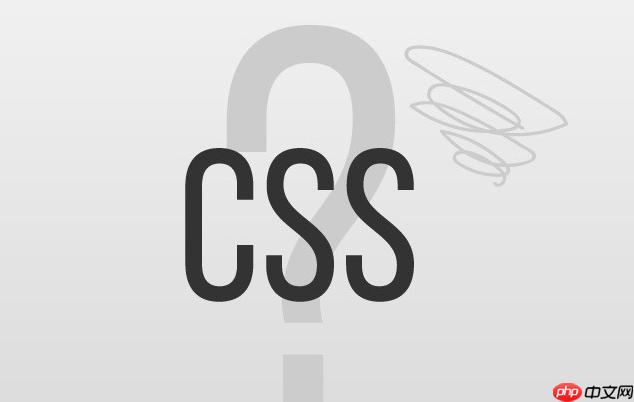CSS定位核心是position属性,relative保持文档流并相对自身偏移,absolute脱离文档流并相对于最近非static祖先定位,二者结合实现精确布局控制。

CSS定位坐标的核心,简单来说,就是通过
position
top
right
bottom
left
relative
absolute
要深入理解CSS如何定位坐标,我们得从
position
position: static;
top
right
bottom
left
真正的定位魔法始于
position
relative
absolute
fixed
sticky
position: relative;
position: relative;
top
right
bottom
left
top: 20px; left: 30px;
.relative-box {
position: relative;
top: 20px;
left: 30px;
background-color: lightblue;
width: 100px;
height: 100px;
border: 1px solid blue;
}值得注意的是,即使它视觉上移动了,它在文档流中占据的空间依然是它原始大小的空间。这意味着,如果它移动后与其他元素重叠,那也是它“挤”过去了,而不是“推开”了别人。我觉得这就像一个人在公交车上,虽然他身体往旁边挪了挪,但他占的座位还是那个座位,别人不能坐。
立即学习“前端免费学习笔记(深入)”;
position: absolute;
position: absolute;
static
static
<body>
<html>
position: relative;
absolute
fixed
sticky
配合
top
right
bottom
left
<div class="parent-container">
<div class="absolute-child"></div>
</div>.parent-container {
position: relative; /* 关键!为子元素提供定位上下文 */
width: 300px;
height: 200px;
border: 2px solid green;
margin: 50px;
}
.absolute-child {
position: absolute;
top: 10px;
right: 10px;
background-color: lightcoral;
width: 50px;
height: 50px;
border: 1px solid red;
}在我的实际开发经验中,
position: absolute;
position: fixed;
absolute
position: sticky;
sticky
relative
fixed
relative
top
right
bottom
left
fixed
理解这几种定位模式,尤其是
relative
absolute
position: absolute
说实话,这是我刚开始学CSS时最常遇到的“鬼打墙”问题之一。你明明写了
position: absolute; top: 0; left: 0;
最常见的误区就是:忘记给父元素设置非static
position
position: absolute;
static
body
html
position: static;
<html>
我记得有一次,我尝试在一个卡片组件里放一个绝对定位的角标,结果角标总跑到页面的顶端。折腾了半天,才发现我忘了给那个卡片组件本身设置
position: relative;
其他可能导致定位错误的因素:
z-index
z-index
top
bottom
left
right
top
bottom
left
right
height
width
top
left
bottom
right
调试技巧,我的经验之谈:
position
top
right
bottom
left
position
static
position: relative;
border
background-color
记住,绝对定位的强大在于它的灵活性,但这种灵活性也要求你对它的工作原理有清晰的认知。一旦掌握了“参照物”这个核心概念,大部分绝对定位的难题都能迎刃而解。
position: relative
margin
这是一个非常好的问题,因为它们都能让元素“看起来”移动了位置,但其背后的机制和对文档流的影响却截然不同。在我看来,理解这两者的区别是掌握CSS布局的关键一步,避免一些潜在的布局陷阱。
position: relative
top/right/bottom/left
原理: 元素在文档流中仍然占据其原始位置和空间。
top
left
对文档流的影响: 不影响周围元素的布局。即使元素视觉上移动了,它原来的“坑”还在那里,其他元素不会因为它的移动而重新排列。这可能导致元素重叠。
主要用途:
position: absolute;
.box-relative {
position: relative;
top: 10px; /* 视觉上向下偏移10px */
left: 10px; /* 视觉上向右偏移10px */
background-color: lightgreen;
width: 100px;
height: 100px;
float: left; /* 假设有浮动 */
}
.another-box {
background-color: lightgray;
width: 100px;
height: 100px;
float: left; /* 它会紧挨着.box-relative的原始位置 */
}在上面的例子中,
.another-box
.box-relative
.box-relative
margin
原理:
margin
对文档流的影响: 会影响周围元素的布局。
margin
主要用途:
margin: 0 auto;
.box-margin {
margin-top: 10px; /* 实际向下推开上方元素或容器10px */
margin-left: 10px; /* 实际向右推开左侧元素或容器10px */
background-color: lightsalmon;
width: 100px;
height: 100px;
float: left;
}
.another-box-margin {
background-color: lightgray;
width: 100px;
height: 100px;
float: left; /* 它会被.box-margin的margin推开 */
}这里,
.another-box-margin
.box-margin
margin-left
什么时候该用哪个?
我的判断标准是:
margin
margin
position: relative;
position: relative;
position: absolute;
简而言之,
margin
relative
元素居中,这简直是CSS布局的“圣杯”问题,方法五花八门。绝对定位确实是其中一种经典且有效的方案,但随着CSS的发展,现代布局方式(如Flexbox和Grid)提供了更优雅、更强大的选择。这里,我们先聚焦绝对定位的实现,再对比一下现代方法的优势。
使用position: absolute;
这种方法的核心思路是:让元素的中心点与父容器的中心点重合。
父元素设置定位上下文: 像我们之前强调的,为了让绝对定位的子元素相对于父容器定位,父容器必须设置
position: relative;
子元素脱离文档流并定位到中心:
position: absolute;
top: 50%;
left: 50%;
transform: translate(-50%, -50%);
transform
<div class="center-container">
<div class="center-item-absolute">
我居中了
</div>
</div>.center-container {
position: relative; /* 提供定位上下文 */
width: 300px;
height: 200px;
border: 2px dashed purple;
margin: 50px auto; /* 容器自身居中 */
}
.center-item-absolute {
position: absolute;
top: 50%;
left: 50%;
transform: translate(-50%, -50%); /* 核心居中技巧 */
background-color: #ffebcd;
padding: 20px;
border: 1px solid orange;
/* 元素宽度和高度可以不固定 */
}这种方法的优点是兼容性非常好,几乎所有浏览器都支持,而且元素尺寸可以不固定。缺点是元素脱离了文档流,可能会影响其他元素的布局,或者在复杂场景下管理起来比较麻烦。
与现代CSS居中方法的对比:
现在,我们有了更强大、更语义化的布局工具,它们在很多情况下比绝对定位更优。
Flexbox (弹性盒子) 居中: 这是我日常开发中最常用的居中方式,尤其是对于单个元素或一行/一列元素的居中。
display: flex; justify-content: center; align-items: center;
.center-container-flex {
display: flex; /* 激活Flexbox布局 */
justify-content: center; /* 水平居中 */
align-items: center; /* 垂直居中 */
width: 300px;
height: 200px;
border: 2px dashed teal;
margin: 50px auto;
}
.center-item-flex {
background-color: #e0ffff;
padding: 20px;
border: 1px solid cyan;
}优点: 简单、直观、元素仍在文档流中、对多个子元素也适用(它们会根据Flexbox规则排列并居中)。 缺点: 主要用于一维布局(行或列),对于复杂的二维布局可能需要嵌套Flexbox。
Grid (网格布局) 居中: Grid在处理二维布局时尤其强大,居中一个元素也是小菜一碟。
display: grid; place-items: center;
.center-container-grid {
display: grid; /* 以上就是CSS怎么定位坐标_CSS绝对相对定位与坐标控制教程的详细内容,更多请关注php中文网其它相关文章!

每个人都需要一台速度更快、更稳定的 PC。随着时间的推移,垃圾文件、旧注册表数据和不必要的后台进程会占用资源并降低性能。幸运的是,许多工具可以让 Windows 保持平稳运行。

Copyright 2014-2025 https://www.php.cn/ All Rights Reserved | php.cn | 湘ICP备2023035733号